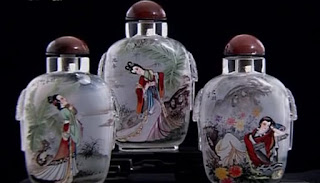Internal painting, or inside painting (
内画), is a relatively new art form created in the late 1880s. It is used to decorate snuff bottles by painting on the inside or internal wall of the bottles using specially designed brushes or tools.
How this art form started or come about is really interesting. Snuff bottles were used in early days (early Qing dynasty) to contain powdered tobacco, they were often carried by the Qing Emperors and court officials wherever they went. Occasionally they would dug out some powdered stuff (from a tiny spoon which was part of the stopper) and put it on the palm where they would take a sniff. It is like modern day when one would take out a cigarette from the pack and start puffing with it.
It was told that there was this somebody who had a habit of sniffing from the stuff put in the snuff bottle. One day when he woke up from a sleep, he was terribly in need of a sniff (like drug addicts today) but unfortunately he found that the snuff bottle was empty. Out of desperation, he used a small stick to dig out whatever stuff stuck on the wall of the bottle. In this way he could still satisfy his desire for a sniff at the remnant tobacco powder.
 |
| After digging at the wall of the snuff bottle |
His action immediately prompted someone nearby with an idea. These bottles could well be painted on the inside wall using some small fine brushes. Snuff bottles were big business in those days as most affluent people liked to show off their bottles as a sign of wealth and position. Soon, many artists began decorating the inside wall of the snuff bottles with beautiful art paintings. This was the humble beginning of the new art form called internal painting or inside painting (
内画). It is still carried out today by many artists who specialize in this art form and created many paintings inside the snuff bottles. Of course, today nobody is indulged in the sniffing of stuff form such bottles. They are solely meant for art appreciation and as souvenirs when one travels to China.
Snuff bottles can be made from many different materials, from porcelain, glass to quartz crystals. Obviously the value of these bottles depend on the fame and recognition of the artists who painted on them. Some masters' works can cost tens of thousands of dollars. Recently, antique snuff bottles had been auctioned for millions of dollars.
Below are some of my collection of snuff bottles from the early 1900s.
 |
| 丁二仲款 1920 |
 |
| 叶仲三之子叶菶祺款 |
 |
| 毕荣九款:(1874年—1925年) |
 |
| 叶仲三款 (1875 - 1945) |
 |
| Painted in 1908 |
 |
| 周乐元款 1901 |
 |
| Contemporary |
 |
| 叶蓁祺 |



























































